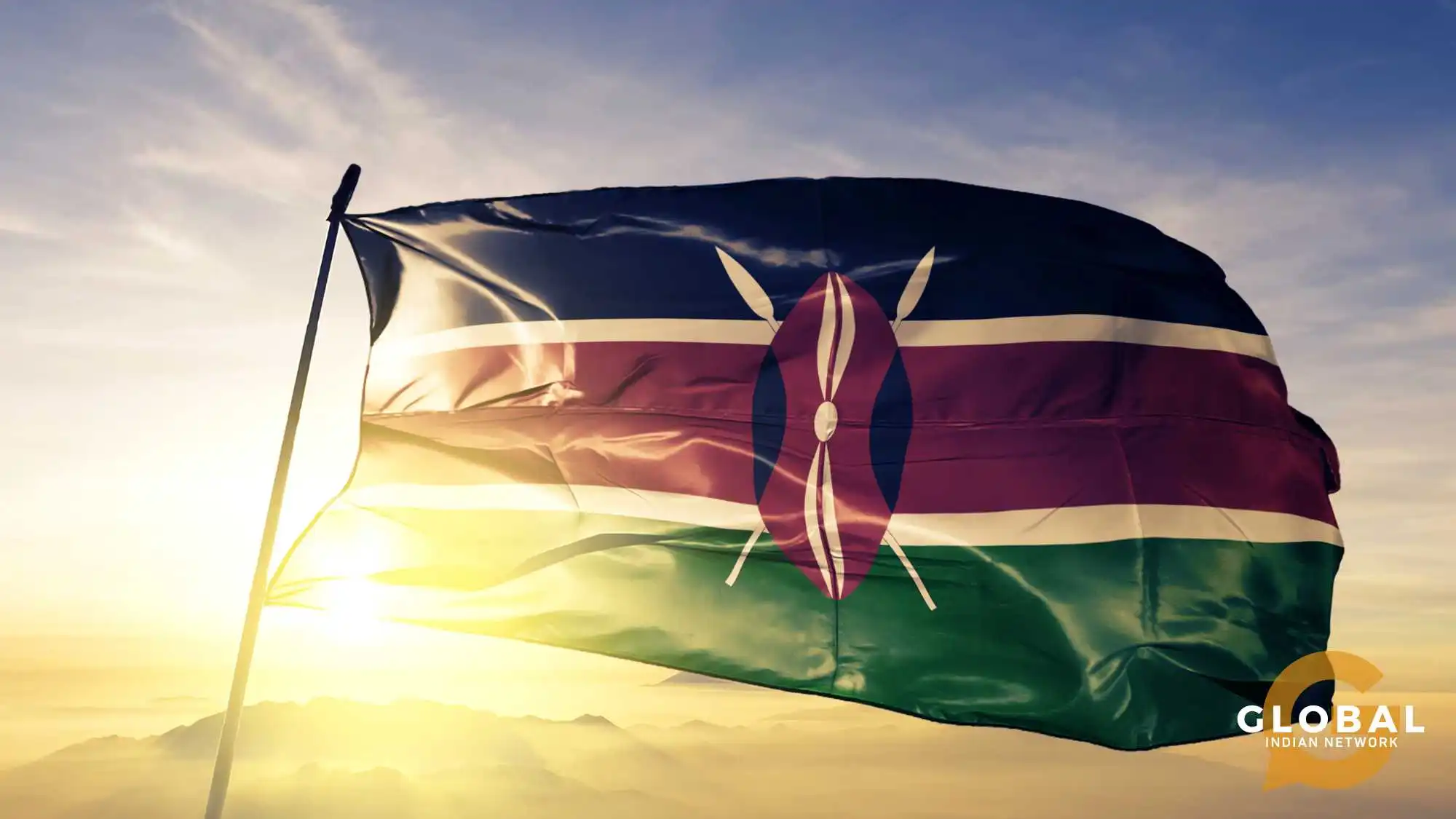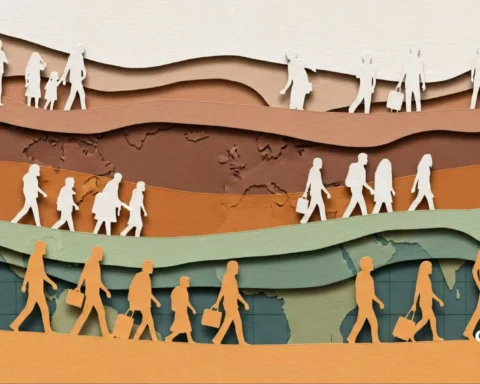Nestled in the heart of East Africa, Kenya shares its borders with Ethiopia to the north, Somalia to the east, Tanzania to the south, Uganda to the west, and South Sudan to the northwest. This vibrant country is a melting pot of cultures and landscapes.
A British colony, Kenya has a diverse climate with tropical warmth in coastal regions, arid deserts in northern deserts, and cooler, temperate zones in central highlands. With over 55 million people and 40 ethnic groups, Kenya gained independence in 1963 and has undergone political and economic transformations, focusing on governance and economic growth.
Kenya, a republic with a multi-party system, has made significant strides in economic development and infrastructure, but also faces challenges like political instability and corruption, as its president serves as both head of state and government.
Image created by the author with AI
Kenya’s economy is diverse, with key sectors including agriculture, tourism, manufacturing, and services. Agriculture, particularly tea, coffee, and horticulture, is a major export. Kenya’s national parks, such as Maasai Mara and Amboseli, attract tourists due to their wildlife and natural beauty.
The stunning beauty and rich cultural tapestry of Kenya reveal a new adventure and every climate zone tells its own story. Yet, there is another story that has the potential to reverse progress and peace. This article focuses on the debt crisis that Kenya faces, the reason behind it, the consequences and suggested policy recommendations.
Table of Contents
African Public Debt
Trends in Public debt levels across the world regions sourced from the World Bank World Development Indicators (WDI), World Competitiveness Index report, Worldwide Governance Indicators database and World Economic Outlook database (2000–2019). Source: researchgate.net
To gain the bigger picture, let us look at his graph. It compares the public debt growth of Sub-Saharan Africa, Latin America and the Caribbean, Emerging and Developing Europe, and Emerging and Developing Asia from 2000 to 2019. The vertical axis represents the percentage of debt growth, ranging from 20% to 70%, while the horizontal axis represents the years. The graph shows that Sub-Saharan Africa’s debt increased significantly after 2011, Latin America and the Caribbean had a steady increase, Emerging and Developing Europe’s debt remained relatively stable, and Emerging and Developing Asia’s debt started to rise around 2007.

Kenya’s Public Debt
Kenya’s public debt, currently at $80 billion, accounts for nearly 70% of the country’s GDP, the highest level in two decades. This debt, which includes both domestic and external components, accounts for 34% of GDP as of the end of 2022. The increase is primarily due to increased borrowing for developmental projects and economic stabilization, especially following the COVID-19 pandemic and the Russia-Ukraine war.
Image source: Composition of Debt – Kenya
Debt Trends and Drivers
Debt trends show rising public debt in many countries due to large-scale borrowing for infrastructure projects, social programs, and economic recovery initiatives. Key drivers include persistent budget deficits, political pressures, and external loans. These concerns raise concerns about debt sustainability and long-term economic impacts, especially when combined with weak growth and limited revenue generation. Let us delve into Kenya’s issues in this regard.
Historical Context of Kenya’s Debt Management Policies
Kenya’s debt management policies have evolved over time to address budget deficits and ensure fiscal sustainability. The government has focused on improving access to concessional loans and reducing dependence on commercial loans to manage external debt. This medium-term strategy aims to guide borrowing decisions and ensure fiscal sustainability, addressing the persistent challenges faced by Kenya since gaining independence.
Kenya’s Debt Relationship with China
Kenya’s debt relationship with China, particularly through loans for infrastructure development like the Standard Gauge Railway (SGR), is a significant concern. Kenya owes around $6 billion to China, making it the largest creditor to the nation. This financial relationship raises concerns about Kenya’s economic sovereignty due to the increasing percentage of public debt allocated to servicing these loans.
Significance of the Standard Gauge Railway (SGR)
The Standard Gauge Railway (SGR) is crucial for Kenya’s vision of modernizing transport links, enhancing regional connectivity, and boosting economic growth. However, it faces challenges like low cargo volumes and profitability, raising concerns about the financial sustainability of its investments. Despite serving passenger traffic, the railway has not yielded the expected economic returns.
Drivers of Onerous Debt
Kenya’s burdensome debt situation is primarily driven by substantial borrowing for infrastructure projects, high public debt rates due to reliance on commercial and bilateral loans, and pervasive corruption within government sectors. Corruption inflates project costs and undermines the effective utilization of borrowed funds. Reports of bribery, nepotism, and mismanagement during projects like the SGR highlight how corruption diverts resources away from productive investments, intensifying the cycle of debt accumulation without tangible economic benefits.
Kenyan Debt Compared to Other African Countries
Kenya’s government debt-to-GDP ratio of 70.10% in 2023 is a high borrowing profile compared to other African nations like Nigeria and Ghana, indicating a significant portion of its national economy.
Image source: Comparison of Predicted Debt of African Countries
Kenya’s public debt level in Africa is significant but not the highest, with Ghana and South Africa having higher ratios, Nigeria and Ethiopia maintaining lower levels. This highlights the complex fiscal environment within the continent due to different economic challenges.
External and Internal Debt of Kenya
External debt is borrowed from foreign lenders, such as international organizations and banks, in foreign currency, while internal debt is borrowed domestically from local banks and citizens, usually in the country’s own currency. Balancing these debts is crucial as external debt carries risks due to currency fluctuations and international obligations.
Image source: Kenya’s Public Debt – by Mwango Capital – The Mwango Weekly (substack.com)
Kenya’s public debt levels are increasing due to both external and domestic borrowing, causing economic strain through high interest payments and straining public finances.
Image source: Kenya’s Public Debt – by Mwango Capital – The Mwango Weekly (substack.com)
Composition of External Debt
Image source: Kenya faces a potential debt repayment crunch in 2024 – Economist Intelligence Unit (eiu.com)
Kenya’s external debt, accounting for 54.3% of the total public debt as of September 2023, has increased over the years due to a shift towards reliance on external funding sources, primarily consisting of multilateral loans, bilateral loans, and commercial loans, with multilateral debt growing significantly.

Internal Debt Overview
Internal debt, comprising 45.7% of public debt, has experienced significant growth, primarily involving Treasury bonds and bills, with banking institutions holding 45.2% of government securities. Kenya’s internal debt has surged in the past five years due to persistent fiscal deficits, averaging 7.6% of GDP. The government aims to reduce borrowing to lower interest rates and discourage private investment.
Revenue and Expenditure
Image source: Kenya Revenue and Expenditure
This graph compares the Kenyan government’s total revenue and total expenditure from FY 2013/14 to FY 2022/23. The chart shows the growth in trillions of Kenyan Shillings for each fiscal year, highlighting trends in how government revenue and expenditure have evolved over the past decade.
Image source: Kenya mulls paying workers or debt default | Semafor
In April 2023, Kenya’s government faced a dilemma: delay salary payments for public workers or risk debt default. President Ruto’s decision to delay payments led to civil service union strikes due to high debt servicing costs, which consumed over 60% of government revenue.
Ruto’s chief economic adviser emphasized that defaulting on debts is not an option and the government can finance repayments, despite significant sacrifices. The public debt is currently over 9 trillion shillings, nearing the parliament-set debt ceiling of around $80 billion.
The government faces challenges in managing finances, including increasing revenue collection, liquidity crunch, and rising living costs, which are not yet resolved. The World Bank and IMF are expected to provide financial assistance, but existing issues are expected to persist.
Debt to GDP Ratio of Kenya
Image source: Kenya Public Debt to GDP Ratio
Kenya’s debt-to-GDP ratio was 73% in 2024, indicating high national debt compared to economic output. However, a World Economics GDP database suggests a larger GDP, lowering it to 48.8%. The ratio is predicted to decline to 61.7% by 2029 due to decreasing national debt.

Debt Servicing Challenges
Image source: Kenya’s Public Debt – by Mwango Capital – The Mwango Weekly (substack.com)
As of September 2023, the debt service-to-revenue ratio reached 64.3%, raising sustainability concerns due to the surge in external debt levels.
Image source: Kenya faces a potential debt repayment crunch in 2024 – Economist Intelligence Unit (eiu.com)
The country’s debt servicing costs have risen significantly, reaching a high of 64.3% as of September 2023, exceeding the IMF’s recommended threshold of 30%. This burden has significant implications for fiscal policy, potentially limiting government spending on critical public services and infrastructure development.
Image source: Kenya’s Public Debt – by Mwango Capital – The Mwango Weekly (substack.com)
The chart displays data from 2012 to 2021, comparing domestic interest payments and total tax revenue, and external debt service charges as a percentage of exports of goods and services. It provides insight into Kenya’s debt servicing burden compared to revenue and exports.
Image source: GDP per Capita vs Debt per Capita
The Kenyan government’s budget is heavily strained by debt servicing costs, which consume a significant portion of revenue. Interest payments account for 27% of total revenue, limiting the government’s ability to allocate funds effectively for essential services like health and education. The fiscal deficit is projected at 3.3% of GDP for 2024/25, but there is concern over balancing budget cuts and meeting debt obligations without exacerbating public discontent. President William Ruto warns of “huge repercussions” due to the precarious nature of Kenya’s fiscal situation.
Major Creditors
Image source: Composition of external debt in Kenya by creditor
The World Bank, Kenya’s largest creditor, has increased its debt to the country from $7.2 billion in 2019 to around $10.7 billion by the end of 2022, surpassing China as Kenya’s primary external lender.

Exchange Rate and Foreign Reserves
Kenya’s foreign exchange reserves have seen a significant decline from 2021 to 2024, primarily due to economic pressures. By 2021, the reserves were around $9.5 billion, providing 5.8 months of import cover. However, by 2022, they fell to $7.42 billion, providing only 4.2 months of imports. As of early 2024, reserves cover less than four months of imports, the lowest level in a decade.
Image source: Kenya faces a potential debt repayment crunch in 2024 – Economist Intelligence Unit (eiu.com)
Projection of Debt Crisis
Kenya’s public debt has reached $80 billion, accounting for around 70% of its GDP (June 2023), the highest level in 20 years. With over 50% of government revenue allocated to debt servicing, Kenya risks fiscal insolvency, particularly due to Eurobond repayments in June 2024. Rising global interest rates and local financial pressures make the sustainability of Kenya’s debt situation precarious, necessitating urgent reforms and strategic financial management.
Image source: Kenya’s double-digit debt costs sign of the tough times | Reuters
Kenya issued a high-interest international bond with a 10.375% interest rate to avoid defaulting on a $2 billion bond payment due in June 2024. This move reflects Kenya’s economic challenges, as double-digit borrowing costs indicate financial distress. The country’s debt-to-GDP ratio has risen above 70%, and nearly a third of its government revenues is expected to be spent on interest payments.
Image source: Kenya’s double-digit debt costs sign of the tough times | Reuters
This chart highlights that nearly 20 countries don’t have enough reserves to cover 4 months of crucial imports. The bars represent the number of months of imports each country can cover with their current reserves, ranging from as low as 1.2 months to as high as 5.6 months. Kenya is shown to have reserves that can cover approximately 3.8 months of crucial imports. This places Kenya in the middle range among the countries listed, indicating a moderate level of economic vulnerability in terms of import coverage.
Image source: Kenya – Real GDP growth
Kenya’s GDP grew by 5.2% in September 2022, slightly down from 5.3% in the previous quarter. The data, from March 2010 to September 2022, showed an average growth rate of 5.4%. The highest recorded growth was 13.6% in 2011.
Image source: Kenya’s Public Debt – by Mwango Capital – The Mwango Weekly (substack.com)
The graph shows an upward trend in USD value compared to KES over the period from January 2022 to March 2023, with two lines representing different rates: Central Bank of Kenya (CBK) Mean Rate and Energy and Petroleum Regulatory Authority (EPRA) Mean Rate. The exchange rates range from 113 to 145.
Image source: Kenya’s public debt will cross Ksh11 trillion
Kenya’s public debt has surpassed KSh 11 trillion due to a weak shilling and increased borrowing. The debt is composed of both external and domestic debt, with external debt largely due to exchange rate fluctuations. This is putting pressure on the economy, with a significant portion of government revenue being used to service debt.
Kenya’s currency devaluation is increasing debt servicing costs, particularly for loans from Chinese financial institutions, highlighting economic vulnerabilities. The country’s significant financial ties with China, including large investments and loans, could impact its economic sovereignty and fiscal policy, raising sustainability concerns.
The China-Global South Project is a network of scholars and analysts examining China-Africa relations trends, focusing on economics, societal and political implications for African nations. It encourages diverse viewpoints and enriches discourse on financial dependencies, enhancing understanding of the evolving landscape and encouraging diverse viewpoints in the China-Africa relationship.
Image source: Major Creditors of Kenya
Consequences of Kenya’s Debt Crisis
A debt crisis can cause severe economic instability, leading to higher interest rates, increased borrowing costs, and strain on public finances. It can also result in austerity measures, affecting citizens’ quality of life, and eroding investor confidence, resulting in reduced foreign investment and slower economic growth.

Economic Strain
Kenya’s debt crisis is causing economic strain, with 30% of government revenues allocated to servicing debt, limiting resources for development and public services. This leads to a 70% debt-to-GDP ratio, hindering economic growth and fiscal sustainability. The rising debt costs limit funds for essential sectors like infrastructure, education, and healthcare, hindering Kenya’s development efforts and sustainable economic growth.
Impact on Public Spending
High debt servicing costs result in reduced public spending on essential services like healthcare and education, with the health sector receiving only 11% of the national budget, affecting access to quality public services and reinforcing societal inequalities.
Increased Political Instability
The debt crisis in Kenya has sparked political instability, with public unrest stemming from proposed tax increases to address the budget deficit. This unrest reveals deep dissatisfaction with government policies and could prompt calls for reforms or leadership changes. Since mid-June 2024, Kenya has experienced widespread protests, particularly from Generation Z, highlighting issues like inequality and corruption. The peak occurred on June 25, when demonstrators stormed the national parliament, causing chaos and violence.
Image source: Kenya Situation Update: April 2023 | Rise in Disorder as Opposition Stages Mass Demonstrations (acleddata.com)
President William Ruto refused to sign the Finance Bill, which included taxes on essential items, following the storming of parliament and violence. He dismissed a significant portion of his Cabinet and the attorney general to quell public anger over perceived government incompetence and corruption. Protests persist, demanding accountability and Ruto’s resignation amid police brutality accusations, escalating tensions and triggering further demonstrations across the country.
Higher Borrowing Costs
Kenya’s debt crisis, characterized by high bond yields exceeding 10%, leads to higher borrowing costs. This creates a cycle of borrowing to cover obligations, deepening the debt burden and reducing access to international financial markets.
Long-term Economic Sustainability
The crisis in Kenya is threatening the country’s economic sustainability, as high debt levels and servicing costs limit investment in infrastructure and social programs. The country’s reliance on external borrowing, especially in foreign currencies, increases vulnerability to global market fluctuations.
High debt servicing costs hinder the government’s ability to implement effective fiscal policies, leading to decreased public spending on critical development initiatives, delaying or canceling essential projects, and compromising the effectiveness of economic development plans.
Increased Vulnerability to External Shocks
Kenya’s rising debt servicing costs increase its vulnerability to external economic shocks, including global commodity price fluctuations and foreign investment changes, exacerbated by high levels of external debt, particularly in foreign currencies.
Image source: Commodity prices fluctuate at the global level
Deterred Foreign Investment
Kenya’s high debt levels may deter FDI due to rising servicing costs, causing stagnation in investment flow and hindering job creation and development initiatives due to potential investors’ weighing of fiscal sustainability against expected returns.
Impairment of Long-term Development Plans
Rising debt costs are posing a risk to long-term development plans like Vision 2030, posing economic transformation and community upliftment risks due to limited financial resources for public investment.

Measures Taken By the Government
A debt-ridden nation is shackled and loses its potential to achieve prosperity. The Kenyan government has been taking steps as shown below.
Strengthening Public Investment Management
The Kenyan government is enhancing the Public Investment Management Unit within the National Treasury to conduct comprehensive feasibility studies for development projects, aiming to direct borrowed funds towards productive investments that stimulate economic growth.
Enhancing Revenue-raising Measures
The government is exploring alternative revenue sources and rationalizing public spending to improve its fiscal position, including leveraging the digital economy for additional revenue and promoting resource efficiency to reduce reliance on borrowing for budget financing.
Managing Fiscal Deficits
The government is shifting towards sustainable fiscal policies to manage fiscal deficits, which directly impact public debt levels. The fiscal deficit is set to decrease from 5.7% of GDP in 2023/24 to 3.3% in the 2024/25 budget.
Implementing Debt Management Strategies
The government is actively developing Medium-Term Debt Management Strategies to optimize borrowing between domestic and external sources, focusing on minimizing costs and risks while maintaining sustainability in public debt management.
Participating in Debt Relief Initiatives
Kenya participated in the Debt Service Suspension Initiative (DSSI) during the COVID-19 pandemic to alleviate debt service burdens and redirect funds towards pandemic-related emergencies, reducing immediate financial pressures on the government.
Image source: Debt Service Suspension Initiative by World Bank during COVID-19
Targeting Concessional Loans
The National Treasury is focusing on utilizing concessional loans, which offer lower interest rates and longer repayment periods, to reduce public debt costs and alleviate fiscal pressure associated with commercial borrowing.
Fostering Transparency and Accountability
The government is prioritizing transparency and accountability in financial management to ensure effective debt management, and is working to improve oversight mechanisms within the financial management spectrum.

Framework – Policy Options and Political Considerations
Political stability is of extreme significance when it comes to fiscal measures. Here we suggest a framework with policy options.
Available Policy Options for Debt Management
Kenya can manage its growing debt by improving public debt management practices, refining forecasting methods, and ensuring robust reporting standards. Fiscal consolidation methods, including reducing unproductive public spending and increasing revenue through better tax collection, are essential. Renegotiating debt terms, extending maturities, reducing interest rates, and seeking relief through bilateral and multilateral negotiation channels can also help alleviate Kenya’s financial burden.
Political Landscape and Decision-making Process
Kenya’s political climate is characterized by widespread unrest and opposition towards government debt management strategies, primarily due to tax hikes perceived as punitive due to high living costs, and the ongoing protests have emphasized the need for greater transparency and accountability in fiscal policy formulation.
Debt management decision-making is influenced by political context, with stakeholders like political parties and civil society groups playing crucial roles. Opposition parties often challenge high-level decision-making, leveraging public dissatisfaction to undermine governmental authority and call for fiscal policy changes. The ruling party must navigate public sentiment and find collaborative solutions to address fiscal deficits.
Role of High-level Corruption in Exacerbating the Crisis
Kenya’s debt crisis is exacerbated by high-level corruption, which diverts significant financial resources from essential public services and infrastructure projects, resulting in an annual loss of approximately $6 billion. This misuse of public funds hinders economic growth and increases the government’s debt, as vital resources are either siphoned off or wasted.
Image source: Kenyans worried about economy, crime and corruption
Corruption in major projects like the Standard Gauge Railway (SGR) exacerbates inflated costs and financial mismanagement, reducing economic returns and increasing the overall debt burden. This not only leads to immediate financial loss but also fosters mistrust among citizens, complicating the political landscape for debt management decisions.
Image source: Kenyans want to stay | Pew Research Center
Addressing corruption is crucial for effective debt management strategies, as systemic corruption in government transactions undermines economic reform efforts and makes sustainable debt management nearly impossible.
Unemployment Plays into Debt
Image source: Corruption and nepotism influence employment
Civil Society Agenda
Civil society groups are advocating for transparency and accountability in debt management and government borrowing practices during a debt crisis. They aim to ensure debt relief benefits the broader population, address root causes of debt accumulation like poor governance, and promote sustainable economic development and social justice.
Advocacy for Balanced and Equitable Budgets
Kenyan civil society organizations are advocating for balanced and equitable budgets to efficiently allocate public resources and address social and economic disparities. They believe these budgets should support marginalized communities and ensure equitable allocation of resources, ensuring access to essential services like education, health, and infrastructure. They also promote participatory budget processes, enhancing transparency and accountability.
Proposals to Address Kenya’s Debt Problem
Kenyan civil society advocates are advocating for reallocating debt resources towards development projects like infrastructure, health, and education to prevent corruption and mismanagement. They are also advocating for debt monitoring mechanisms, fiscal discipline, and accountability frameworks to ensure efficient and transparent use of borrowed funds and prevent unproductive borrowing cycles.

Urgency for Action by Both the Kenyan Government and International Actors
Kenya’s debt crisis is a major concern for its socioeconomic stability and growth. Civil society leaders are calling for collaboration between the Kenyan government and international actors like the IMF and World Bank to develop innovative debt relief and sustainable fiscal policies. Addressing the crisis and gaining international support is crucial for promoting long-term economic resilience and aligning government policies with the populace’s needs.
Sustainability of Kenyan Debt
Kenya’s public debt, which accounts for over 70% of GDP, is under scrutiny due to fiscal pressures and high borrowing levels. The country’s reliance on domestic and international loans, including substantial funding for infrastructure projects like the SGR, has strained its fiscal capacity, raising concerns about debt sustainability and the potential for future financial distress.
Image source: Kenya’s Debt Composition
Policy Recommendations
Kenyans are facing economic challenges, including high unemployment rates and high living costs. Corruption is a significant issue, affecting various sectors, including government and public services. Despite these challenges, Kenyans remain optimistic about the country’s future, believing it is heading in the right direction and expecting improvements in their personal economic situations.
Image source: Kenyan’s views of government responsiveness
Based on the above all aspects described above, our policy recommendations are:
Enhance Revenue Generation
Image source: Tax Revenue increase can help reduce debt
As part of increasing revenue, education and therefore employment (taxes as well) could be the first step. Basic skills and later on, upskilling have to be a continuous process that will have the ability to raise the standard of living in an inclusive way.
Image source: Education open up doors
Control Government Spending
Strict fiscal discipline is crucial for controlling government expenditures by prioritizing essential spending and minimizing non-essential ones. Budgetary rationalization helps identify and reduce wasteful spending, improving fiscal balance and reducing borrowing needs.
Pursue Economic Growth Strategies
The government should prioritize accelerating economic growth to boost revenue. This can be achieved through regulatory reforms, entrepreneurship (including startups) support, and investment in infrastructure, which can boost national income and tax revenue.
Image source: Encourage entrepreneurship (including startups)
Improve Public Financial Management (PFM)
Strengthening public financial management practices can enhance accountability, transparency, and expenditure efficiency by establishing robust audit and oversight mechanisms, minimizing financial mismanagement and corruption, and safeguarding public resources.
Implement Debt Management Strategies
The government should establish a comprehensive medium-term debt management strategy that prioritizes sustainability and cost-effectiveness, involving regular debt sustainability analyses, optimizing domestic and external financing, and exploring concessional borrowing options to reduce debt servicing costs.

Explore Debt Restructuring Options
The government should proactively negotiate debt restructuring with creditors when public debt becomes unsustainable, extending repayment periods and reducing interest rates. This approach can lead to quicker resolutions and minimize economic disruptions, as evidenced by previous studies.
Image source: Debt restructuring optimization
Foster Public Awareness and Engagement
Increasing public awareness and engagement about national budgeting and debt issues can improve accountability. Education about public debt implications and fiscal discipline’s importance can lead to increased support for reforms, facilitating political will for change execution.
ALSO READ:
- Tourism in Kenya: From Safari Land to Sustainable Growth
- The Devastating Impact of Inflation Rate in Kenya
Conclusion
Kenya is facing a critical dilemma, balancing progress with its growing debt. The government’s efforts to manage this complex issue require economic acumen, political will, and public support. Kenyans’ voices for a transparent and accountable governance structure are crucial for shaping the nation’s fiscal health and navigating this turbulent landscape.
Kenya needs to improve debt management, increase transparency, and focus on economic growth to tackle challenges. Prioritizing investments with tangible benefits and avoiding projects without substantial returns is crucial. Strengthening fiscal policies and maintaining a balanced borrowing approach is also essential for long-term debt sustainability and economic resilience.
Kenya’s past financial struggles should guide its future growth, ensuring equitable distribution of growth among its citizens, thereby securing a brighter and prosperous future for future generations. Debt burden should not be Kenya’s kryptonite.










